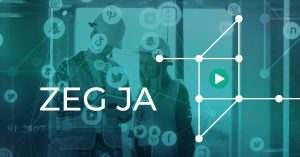
Learning Community Tool
Getting started with the (continued) development of a powerful learning community How can collaboration between companies and educational institutions be


As members of the Better connection to the job market zone, we regularly visit events and conferences. We acquire the necessary knowledge of digitalisation issues and developments. We also like to keep you informed on what’s going on at the intersection of higher education and the labour market in The Netherlands. That’s why, in this report, we share a number of developments in the field of improving data-driven connection to the labour market. We recently visited a session on the manifesto ‘Vrije Zones’. Central to the manifesto is the question: How can we use data even better to improve the connection between education and the professional field? Keep reading to find out.
Developments regarding a future-proof form of education are increasingly starting to emerge. An independent party published the manifesto Vrije Zones on 15 July 2020. In November of the same year, clients Albeda, Rotterdam University of Applied Sciences, Inholland, and Zadkin organised anonline conference devoted to the manifesto to explain important aspects of it. One of the highlights was a response from the Minister of Education, Culture and Science Ingrid van Engelshoven.
During the session “How can educational professionals interpret forecasts for their educational innovation?” The use of data-driven looking at supply and demand on the labour market was highlighted:
“We use numbers to inform students and the market: where are the opportunities? And also: where aren’t there?”
“Labour market information is readily available, but it’s not integrated enough in job orientation trajects”
Didier Fouarge is referring to the fact that we already provide institutions and students with dashboards with figures, but we leave out what to do next. Discussing these figures with students in the context of personal career development is an example of such a step.
In the manifesto, it’s recommended to further deepen data analysis in this area. For example via regional data centres, which are specially set up for this purpose. After the conference, I spoke with Marc van der Meer about this idea in more detail. As a member of the independent party, he prepared the proposal for regional data centres, w here he emphasizes the importance of looking further:
“Numbers about demographics, job openings, vacancies, replacements are nice. But you want to go deeper: how can you make meaningful education based on these numbers?”
Thus, more data and information are required. As an educational institution and business community, you don’t want to simply match supply and demand. This match could also be improved in terms of educational content, which can be more data-driven. Therefore, in the manifesto, some features were proposed for the use of such a regional data centre. And they are as follows:
During the session and the follow-up interview, good examples of analyses that go deeper than just market data were discussed. There is Matchcare, a career orientation agency from Nieuwegein (NL) that has expanded their labour market analysis with professional skills and talents. In this way, forecasts on skills can also be made. And then there’s CentERdata. They carry out the “IT labour market research with top sectors”. CentERdata is involved, among other things, in data analysis, with Berenschot focusing on qualitative analysis. These reports mainly concern logical career paths when workers change jobs.
The challenge of the coming period is to link such data to the substantive education within the educational institutes themselves.
In the ideal situation of some partners, demography, and supply-demand figures are therefore extended with a content analysis at the vacancy level. In this way, study programmes can identify shifts in the labour market quicker and respond in terms of educational content. Three suggestions have been mentioned so far in this piece:
In the context of educational innovation with IT, this is a nice route to approach the connection to the labour market itself digitally!
Photo by Markus Spiske op Unsplash
Share this page

Getting started with the (continued) development of a powerful learning community How can collaboration between companies and educational institutions be

Integrate digital competences into profiles for (higher) education and work Does a nurse know how to handle his patient’s electronic

SAY YES TO DIGITISATION Everything is digital. Communicating, learning, excelling. Everything. The world is full of digital stimuli. Find out

Getting started with the hybrid learning envoironment tool Starting up a hybrid learning environment: how do you do it and